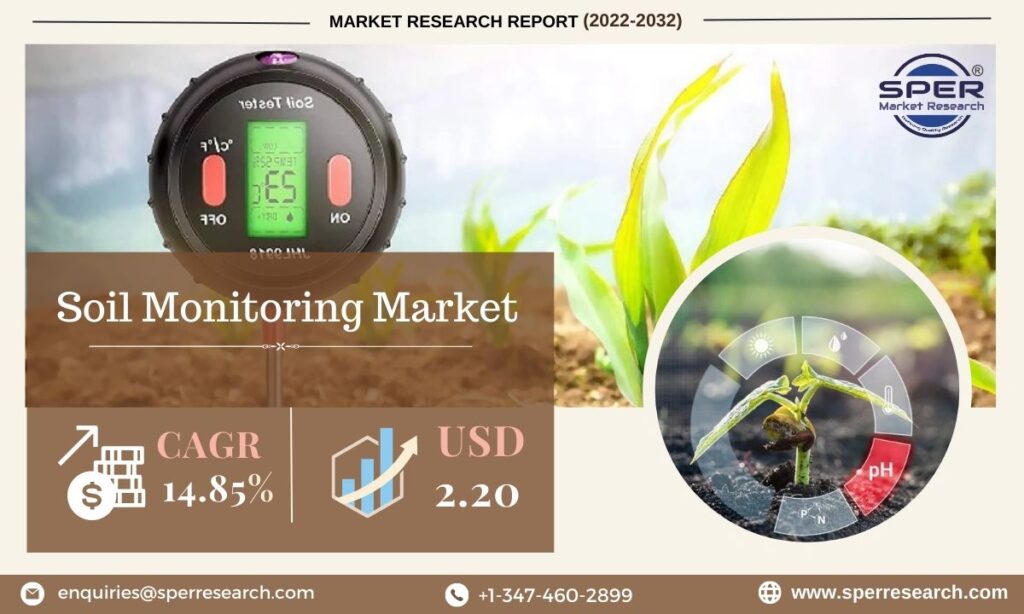Soil Monitoring Market Share and Growth, Emerging Trends, Industry Size, Demand, Key Players, Competitive Analysis, Future Opportunities and Revenue Forecast till 2022-2032: SPER Market Research

Examining the soil’s stability, composition, and physical state is a part of soil monitoring. Devices used in soil monitoring systems carry out a variety of tasks, including reading and storing data, soil sensing, and sending data to computers via a transmitter. Decision-making is made possible by the soil monitoring data’s assistance in analysing the soil conditions. Agricultural practises, golf courses, research facilities, and urban farming communities are just a few of the places where these systems are used extensively.
According to SPER market research, ‘Soil Monitoring Market Size- By Component, By Connectivity, By Application – Regional Outlook, Competitive Strategies and Segment Forecast to 2032’ claim that a CAGR of 14.85% is expected to cause the Global Soil Monitoring System Market to reach USD 2.20 billion by 2032.
The growing demand for higher agricultural production to feed an expanding population, as well as the rising popularity of precision agriculture and fertility management services, are the main factors propelling the soil monitoring system market. The industry is also growing because technologically advanced soil monitoring equipment is becoming more readily available and less expensive. Additionally, the government’s increased investment in agricultural R&D fuels the sector. The rising demand for agricultural products, the changing climatic conditions, concerns about soil quality, and technical developments in the agriculture business have all led to a new set of opportunities for those involved in the agriculture value chain.
The low level of public awareness of soil monitoring is a significant barrier to the market’s expansion. The advantages of soil monitoring are not well known among many end users in the agricultural, residential, landscaping, and sports turf industries. Only a small percentage of farms currently have soil monitoring sensors, largely because manual inspection and visual assessment are still the most popular alternatives. Due to the high cost and unaffordability of these sensors for smallholders, there are few options available to facilitate the adoption of soil monitoring sensors, equipment, devices, and solutions.
Request For Free Sample Report @ https://www.sperresearch.com/report-store/soil-monitoring-market.aspx?sample=1
The COVID-19 has highlighted the importance of soil monitoring systems in ensuring food security and sustainability, but it has also provided challenges for the industry to overcome. Due to the increased demand for food production, the pandemic has impacted the market for Soil Monitoring Mystems. As people spend more time at home and seek self-sufficient lifestyles, urban farming and home gardening have grown in popularity. Soil Monitoring technology has become an essential tool for maximising agricultural yields due to the capacity to monitor soil conditions and make modifications. However, the epidemic has also caused supply-chain snags that have raised the price and slowed down the delivery of raw materials and parts for soil monitoring equipment.
Geographically, North America emerged as the dominant region in the Soil Monitoring Industry because farmers in this region have started using remote sensing imaging technology as a result of a labour shortage, which will increase the demand for sophisticated soil moisture monitoring equipment. Over the course of the projection period, it is anticipated that the market for global soil monitoring systems would expand as a result of the rising use of automated equipment. Others, Earth Observing System, Element Materials Technology, Manx Technology Group, METRE Group Inc., and Campbell Scientific Inc. are some more important market participants.
Global Soil Monitoring Market Segmentation:
By Component: Based on the Component, Global Soil Monitoring Market is segmented as; Hardware, Software, Service
By Connectivity: Based on the Connectivity, Global Soil Monitoring Market is segmented as; Wired, Wireless
By Application: Based on the Application, Global Soil Monitoring Market is segmented as; Agriculture, Archaeology, Construction& Mining, Research
By Region: The Soil Moisture Sensors Market is segmented into North America, Europe, Asia Pacific, and the Rest of the World based on geography. The global Crop Monitoring Market is growing rapidly, with strong demand for precision farming techniques and sustainable farming practices. North America is the leading region in the market, due to the large-scale adoption of advanced technologies in the agriculture sector. The European Global Soil Monitoring Devices Market is growing rapidly, as countries in the region adopt smart agriculture practices and sustainable farming techniques. The Asia Pacific soil monitoring market is projected to grow fastest, due to the high demand for precision farming technologies in countries such as China, India, and Japan. Latin America is a large market for soil monitoring, as demand for food and agriculture products continues to increase. Brazil, Argentina, and Mexico are the major contributors to the market in the region, and technological advances, such as IoT and big data, are driving growth. Governments are also promoting advanced farming technologies, which is driving the market growth.
For More Information, refer to below link:-
Soil Monitoring System Market Future Outlook
Related Reports:
Follow Us –
LinkedIn | Instagram | Facebook | Twitter
Contact Us:
Sara Lopes, Business Consultant – U.S.A.
SPER Market Research
+1-347-460-2899





